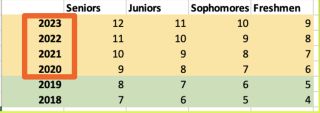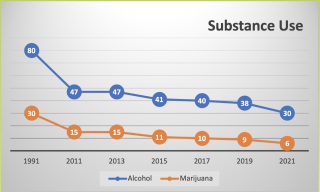Adolescence
Teenage Mental Health: This Time, the Crisis Isn't Hyped
Teen depression, isolation, and hopelessness will echo across the decades.
Posted March 27, 2023 Reviewed by Davia Sills
Key points
- Adolescents are in their fourth year of disrupted community.
- In addition to individual stress, their support networks are stressed and disrupted as well.
- Social problem behaviors like drinking are down, but depression and suicidal ideation are at record highs.
- Almost 1 in 10 teens has attempted suicide in the last year.
I love teenagers.
According to every documented source I have read—going back to the Ancient Greeks—teenagers and "youth" have always been in crisis.
So when I read a whole spate of news articles saying that adolescents were in the midst of an unprecedented mental health crisis in the New York Times, Washington Post, and many other credible news sources, I shrugged it off. Bad news sells.
However, when I started to carefully read recent CDC reports on the state of adolescent mental health, I paused. What I read was sobering. It should concern us all. These findings are—frankly—scary. Like the Great Depression, World War II, and the Baby Boom, I think we will see the echoes of this current over the course of decades.

Adolescents Have Missed A Central Pillar of Positive Development: Stability
Although adolescents’ mental health decline began in 2011, there seems to be clear evidence that the pandemic's isolation, stress, and disruption have exacerbated pre-existing problems.
This chart shows when the pandemic began disrupting adolescents’ lives. For most people in the US, the pandemic first disrupted school in Spring 2020. Seniors’ entire high school careers—9th to 12th grade—were shaped by Covid. Juniors were affected beginning in 8th grade. The current class of high school freshmen last had a "normal" school year when they were in elementary school.
I begin a discussion of adolescent mental health with this information, because it puts teens' lives in context.
Think of all the core developmental tasks that occur during adolescence:
- Negotiating puberty
- Major transitions from the family into the peer group
- Initiation of romantic and sexual interest and behavior
- Major cognitive changes in how adolescents learn to read social situations and negotiate friendships
For students in high school today, all of those transitions occurred in the context of relative social isolation and high levels of stress. Importantly, this stress was systemic. It occurred in their individual lives—many students experienced Zoom classrooms, canceled sports, and limited opportunities for play and work.
Even more importantly, however, these changes caused changes in the lives of their families. Parents' lives were disrupted. Siblings were stressed. Friends moved or—both because of their own isolation and the stress in their own lives—could not provide the support they normally would. Truancy has hit record highs. Many children—more than has yet been adequately documented—have disappeared from school rolls.
When one person is stressed, they can rely on their social network. When everyone is stressed, that safety net is gone.

The Good(ish) News: Problem Behaviors Teens Engage In With Others Are On the Decline
All news is not bad news, and some adolescent trends are positive.
Adolescents report a sharp decline in substance use. This is true for both alcohol use and—surprising to me—marijuana use as well.

Sexual behavior is also down, as is teen pregnancy. Consistent with long-term trends, fewer adolescents are engaging in genital sex with others, and fewer have had multiple partners. This latter is important as having multiple partners is a risk factor for sexually transmitted infection and disease.
Perhaps surprisingly, especially given the sharp rise in crime experienced during the pandemic, exposure to violence has remained unchanged.
Although all these trends are welcome, it is interesting to note that the good news about adolescence is in the kinds of behaviors that many consider "adolescence-limited" problems. Drinking and sexual behavior are often considered problematic for teens, but not for adults. They are the kinds of things that teens do when they are hanging out with their friends. Is this an overall sign of good decision-making on the part of teens? Or is it a positive side effect of social isolation?
The Bad News: Adolescent Mental Health
The bad news is in mental health. The Centers for Disease Control and Prevention (CDC) Summary of ten-year trends from the Youth Behavioral Risk Survey is sobering.
- 57 percent of girls and 29 percent of boys report persistent feelings of sadness and hopelessness—a core indicator of depression.
- 30 percent of girls and 14 percent of boys have seriously considered suicide in the last year.
- 24 percent of girls and 12 percent of boys have made a suicide plan—what should be a prompt for immediate action by parents and caregivers.
- 13 percent of girls and 7 percent of boys have made a suicide attempt in the last year.
Think of any gathering of adolescents. A graduation. A football game. A school dance. Visualize it. One in 10 of those kids has made a suicide attempt in the last year.
Although much has been made of the gender difference between boys' and girls' attempts, it should be noted that although girls are more likely to attempt suicide, boys tend to use more lethal methods and are more likely to succeed. Both numbers are frighteningly high.
The trends summarized by the CDC of nationally representative data ends in 2021. It's now 2023. By all accounts, adolescent mental health has gotten worse. Parents continue to report high levels of stress. Although schools are back in live session, teachers are reporting unprecedented levels of stress among students and are leaving the profession in droves. Many of the financial and social supports put into place during the COVID crisis—including health care and mental health services—are about to end.
It is time we take this crisis seriously. Think hard about the teens in your life. What can you do to help?




